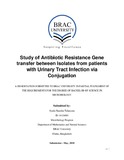Study of antibiotic resistance gene transfer between isolates from patients with urinary tract infection via conjugation

View/
Date
2018-05Publisher
BRAC UniveristyAuthor
Tabassum, Syeda NaushinMetadata
Show full item recordAbstract
The Urinary Tract Infection is caused recurrently by Escherichia coli and also by Proteus spp., Klebsiella spp., Enterococcus spp., Staphylococcus spp. etc. [3, 11] Recently, UTIs are considered a severe public health concern due to the increasing antibiotic resistance in between the strains and species of the Enterobacteriaceae family. These multi-drug resistant forms (MDRs), due to subsequent use of antibiotics, transfer their antibiotic resistance genes by horizontal gene transfer methods. Conjugation allows gene transfer not only within species but also in-between closely related species, given that the cells have direct cell-to-cell contact. These resistance genes could be a part of either the resistance plasmids (R-plasmids) or Fertility plasmid (F-plasmid) and often times chromosomal DNA as well. Thus, this investigation aims to determine whether horizontal gene transfer takes place between the naturally occurring causative agents leading to an increase in MDRs. Therefore, the study tests the antibiotic susceptibility of the isolates from UTI patients using both the Kirby-Bauer Disk Diffusion and Agar Dilution, to determine the MIC and MBC values of the isolates. After the interpretation of antibiotic sensitivity using the Rapid Plasmid Extraction Technique by Kado-Liu, the plasmids of the isolates were extracted and separated using the Agarose Gel Electrophoresis. Using the plasmid extraction results, the presence or absence of plasmids were determined which would lead to the determination of donor and recipient strains for conjugation. After conjugation, the donor organisms were cured to further strengthen the results and outcome of the investigation. The results shows a suspected isolate Escherichia coli, azithromycin resistant (MIC>100μg/ml), as the donor, and another suspected isolate Shigella spp. azithromycin sensitive (MIC>60 μg/ml), as the recipient did not conjugate together and the likely reason would be due to absence of resistance genes in the plasmid which is the only form of DNA that is transferred via pillus adjoining the donor and recipient cell. This conclusion was drawn from plasmid curing where the results shows that even at higher concentrations of EtBr (100μg/ml) and SDS (20%), the donor isolate grew and showed resistance against azithromycin, despite their plasmids being removed (as seen from plasmid extraction and gel electrophoresis). Hence it could be deduced that conjugation does not transfer the chromosome mediated antibiotic resistance gene. However, further confirmation on the plasmid being a Fertility plasmid or not, would have further backed up the results of this investigation and shed light on some interesting future aspects of this investigation that could lead to a positive result for conjugation and even further enquire about the resistance gene.
